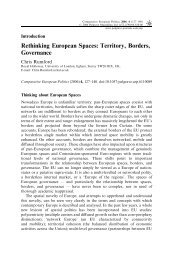Europeanisation, National Identities and Migration ... - europeanization
Europeanisation, National Identities and Migration ... - europeanization
Europeanisation, National Identities and Migration ... - europeanization
Create successful ePaper yourself
Turn your PDF publications into a flip-book with our unique Google optimized e-Paper software.
10 Anna Tri<strong>and</strong>afyllidou <strong>and</strong> Willfried Spohn<br />
Western European community <strong>and</strong> at the same time to be protected <strong>and</strong> shielded<br />
against renewed threats from the East, Russia <strong>and</strong> Asia. This is the general<br />
motivational basis for the wish to become, as soon as possible, member states of the<br />
European Union. In cultural terms, the West, not only Western Europe, but also<br />
America represents a model to be emulated as a direction for societal, economic <strong>and</strong><br />
political progress. At the same time, it is also a model to defend oneself from, because<br />
it is more powerful, expansive <strong>and</strong> undermining of traditional cultures, lifestyles,<br />
values <strong>and</strong> identities. Again, these cultural re-definitions of collective identities<br />
depend on the geopolitical location within the European space. In this volume,<br />
we seek to cast light on these processes through the study of the Hungarian, Polish<br />
<strong>and</strong> Russian cases. Hungary presents an important challenge because of its imperial<br />
historical experience <strong>and</strong> the current division of the Hungarian nation into<br />
one mother country <strong>and</strong> many diasporic communities, to be segregated in the<br />
near future by the Schengen border zone (see the chapter by Tóth <strong>and</strong> Sik in this<br />
volume). Pol<strong>and</strong> plays a pivotal role in its location between the united Germany <strong>and</strong><br />
its historical imperial neighbours from Lithuania to the Ukraine (see the chapters<br />
by Marody <strong>and</strong> Spohn in this volume), while Russia <strong>and</strong> its self-definitions towards<br />
its neighbouring Others sets a symbolic <strong>and</strong> geopolitical borderline between Europe<br />
<strong>and</strong> Asia (see the chapter by Stölting in this volume). Moreover, in the aftermath of<br />
11 September, the representation of Russia by itself <strong>and</strong> other countries as part<br />
of ‘the West’ has acquired new emphasis. Its role as the symbolic <strong>and</strong> geopolitical<br />
border between ‘the West’ <strong>and</strong> ‘the Islamic world’ – where either are seen as<br />
homogenous <strong>and</strong> compact – has been cast with renewed emphasis. Other interesting<br />
examples of social <strong>and</strong> territorial boundary (re-)constructions are the Baltic countries<br />
between northern Europe <strong>and</strong> Russia <strong>and</strong> the Balkan countries <strong>and</strong> Turkey in the<br />
southeastern corner of the European continent.<br />
Immigrants as Others<br />
Within the overall process of European integration <strong>and</strong> Eastern enlargement<br />
<strong>and</strong> the related reconfiguration of national <strong>and</strong> European identities, immigration<br />
remains a largely unsettled issue. It is our aim in this book to highlight the<br />
ingroup–outgroup dynamics that condition the relationship between the nation<br />
<strong>and</strong> the immigrant(s) both in general <strong>and</strong> with particular reference to the process<br />
of European integration. ‘Othering’ the immigrant is functional to the development<br />
of national identity <strong>and</strong> to achieving or enhancing national cohesion. The<br />
immigrant is a potential threatening Other because s/he crosses the national<br />
boundaries challenging, thus, the ingroup identification with a specific culture,<br />
territory or ethnic origin as well as the overall categorisation of people into nationals<br />
<strong>and</strong> others. In other words, the immigrant poses a challenge to the ingroup’s<br />
presumed unity <strong>and</strong> authenticity, which it threatens to ‘contaminate’.<br />
Most European countries conceive of themselves as national states, where the<br />
state is the political expression of the dominant nation. This idea implies a static view<br />
of culture <strong>and</strong> ethnic descent: these are seen as homogeneous <strong>and</strong> unique. The<br />
presumed purity <strong>and</strong> authenticity has to be protected from the intrusions of



